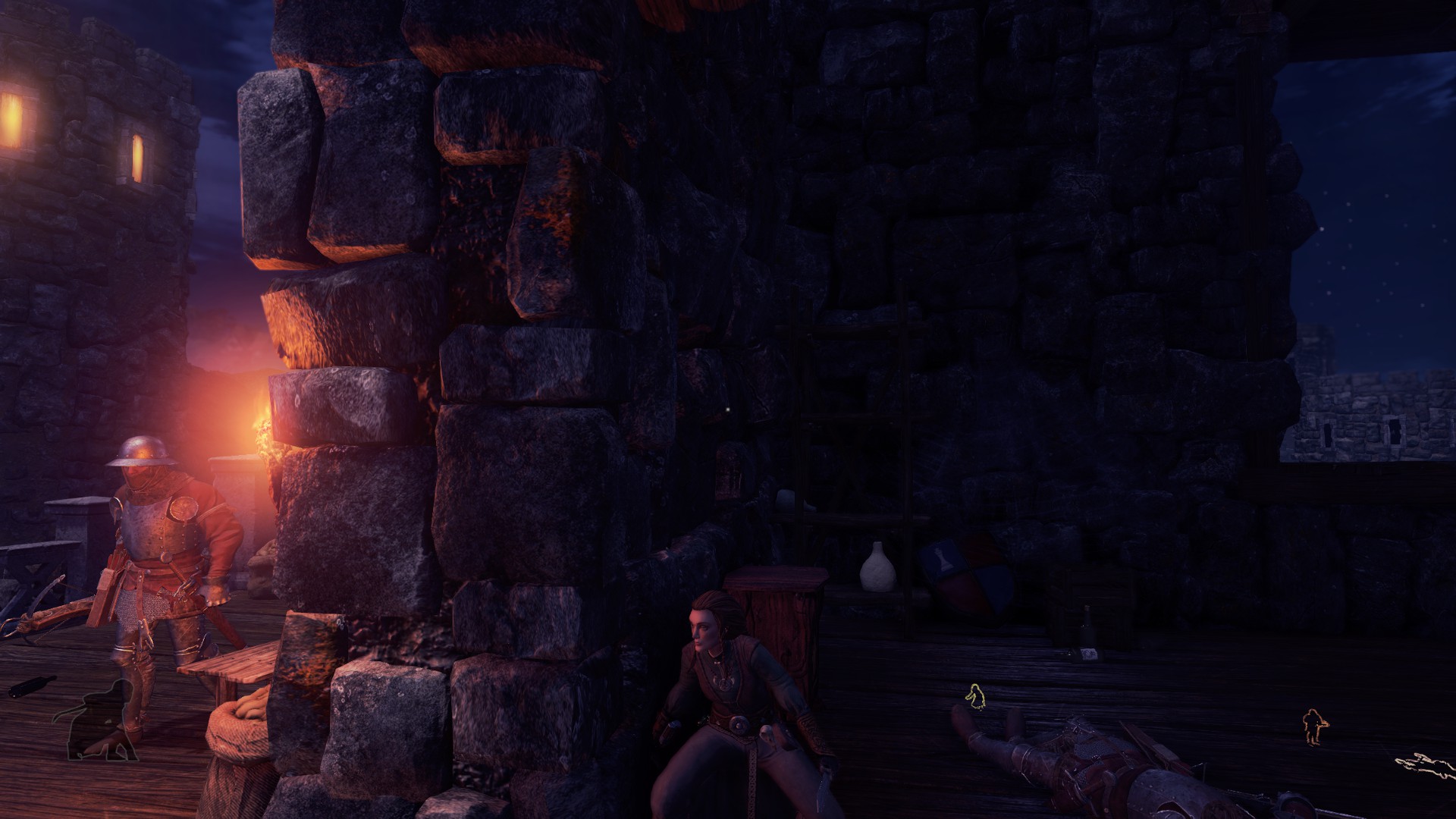Our Verdict
Shadwen begins with promise, but has neither the depth nor the variety needed to fulfill it.
PC Gamer's got your back
What is it: A third-person stealth game about an assassin bent on killing the king, and the little girl she brings along with her.
Influenced by: Thief, Trine 3
Reviewed on: Intel Core i5-6600, 16GB RAM, Nvidia GTX 960, Windows 10
Price: $16
Release date: Out now
Publisher: Frozenbyte
Developer: Frozenbyte
Multiplayer: None
Link: http://www.shadwen.com/
Shadwen is the ultimate assassin. She moves like a cat, climbs like a monkey, and kills swiftly, silently, and utterly without remorse. She's a lean, mean, murderin' machine. She is also, after the opening sequence of the game that bears her name, a surrogate mother of sorts, as she reluctantly takes charge of an equally sneaky but not nearly as murderous girl named Lily. Thus we have the central conflict: Can Shadwen complete her mission to murder the king while preserving Lily's innocence—and more to the point, does she care enough to even try?
Stealth games generally rely on enemy NPCs who aren't great at their jobs, and Shadwen, a very linear, third-person game of sneaking and murder, is no exception. Guards have very short, narrow fields of vision, and hiding in bushes or haystacks renders Shadwen and Lily invisible, even when searching guards are practically standing on top of them. But while Shadwen can climb, jump, and swing from her grappling hook, Lily cannot. She’s limited to running between hiding places, advancing automatically through the streets and corridors when the guards aren’t looking. Your job as Shadwen, then, is to ensure their backs are turned at the appropriate times, usually by pushing, pulling, or knocking over the crates and barrels that are stacked just about everywhere. Nearby guards will move to investigate, and Lily, hopefully, will slip through.

This is often where the AI goes from 'forgiving' to 'wonky.' Guards are only alerted if Shadwen is spotted, so Lily is effectively unseeable: She won't move into a guard's line of sight, and they’re forbidden by the game's internal rules from spotting her. But occasionally, Lily will be caught out in the open, perfectly visible, and yet the guard who's looking right at her won't react to her presence. He’ll just stand there, motionless, until the AI chugs along enough to allow her to move, either to her target location or back to her original hiding spot.
Moves that don't work out can simply be rewound and tried again.
Shadwen herself doesn't get that kind of leeway: Being spotted by a guard is an instant game over. But failure doesn't mean being kicked out to a save/load screen. Instead, there's a time rewind mechanic that allows you to go back a few seconds, or as far as the previous save checkpoint, and take another run at whatever you screwed up. I really like this, because it makes experimentation very easy: Moves that don't work out can simply be rewound and tried again.
The default movement system works in a similar fashion, as time only advances when Shadwen is in motion (or when a ‘pass time’ key is held). Real-time movement is an option if that's your preference, but I very quickly came to prefer the auto-pause system because it let me more precisely execute tricky maneuvers, like stringing together multiple, Spider-Man style grapples—Shadwen will stop even in mid-air if no keys are being pressed. Die-hard platformers may disapprove, but I was quite happy to enjoy the pleasure of pulling off ninja-like moves without the usual frustration that comes from having decidedly un-ninja-like fingers.

No-frills kills
I figured out Shadwen's real secret in the early stages of the game's fourth level: Keeping Lily innocent doesn't mean not killing anyone, it means keeping her from finding out about it. Since there are absolutely no penalties for spilling blood as long as Lily stays in the dark, I quickly abandoned the life of pacifism in favor of murders of convenience, and before long, straight-up thrill-killing. Eliminating threats rather than trying to work around them certainly simplified the journey, and it was amusing for awhile too. But it also revealed some of Shadwen’s shortcomings.
For one, although Shadwen purports to allow acts of deep, multi-layered mayhem, it really didn't work out that way for me. Indirect murder is generally limited to dropping or rolling a heavy object onto an unlucky target, or blowing them up by rolling barrels of explosives into fires they're standing too near for their own good. But Shadwen is unable to interact with the world around her in ways beyond pushing things, or pulling them with her grappling hook, and that puts a real damper on her ability to set up complex, environmental kills. In one instance, I came upon an explosive barrel at the top of a ramp leading down to a fire around which three guards were standing—an obvious multi-kill setup. But using the grapple to pull the barrel onto its side so it would roll (because pushing just makes them slide around) left it completely out of position, and trying to aim it was like trying to hit a bullseye with a poorly-made paper airplane. I was finally able to roll it into one of them, causing consternation among all three, and I ended up killing them all with my knife while they tried to track me down. Effective, sure, but routine.

Even when the chance to get crazy presented itself, I never bothered because it was more likely than not to lead to a quick end-of-game.
A number of different traps, like mines and poison dart launchers, are available for crafting based on blueprints and items found in chests—the one sort of semi-secret the game offers—but they're only available in extremely limited amounts, and I never found a use for them beyond novelty kills anyway. And that's risky, because if a guard escapes your deathtrap, he'll run away, sound the alarm, and it's game over. In fact, that happens whenever a guard discovers a corpse, even if there's no evidence of mayhem: run away, sound alarm, game over. So even when the chance to get crazy presented itself, I never bothered because it was more likely than not to lead to a quick end-of-game. Better to kill quietly, stash the corpse, and move on.
There are only two enemy types—the standard guard and, later in the game, the heavily armored guard, who can't be shanked from behind—and their behavior never changes: They walk their path, do a half-assed search if they see or hear something untoward, and are entirely too ready to attribute moving boxes and broken furniture to supernatural forces. The environments don't change much from level to level either; aside from some rather pretty outdoor vistas, the whole thing is very grim and grey.

The most disappointing aspect of Shadwen is the story. Guards talk a lot, as they tend to in stealth games, about the “dark spirits,” the forest the King ordered burned for reasons unknown, and the coming visit of two trouble-making nobles. Over time, it collectively suggests a hidden depth to the tale, especially when conversation turns to the King's potential madness versus the need to keep him on the throne to ensure peace in the kingdom—something that's apparently been sorely lacking in recent history. And yet when Shadwen ends, none of it matters a whit. I don't want to spoil it, but it's all very abrupt and entirely unsatisfying. Even the relationship between Shadwen and Lily is treated as entirely throwaway.
I've been a Frozenbyte fan for years, and a full-on stealth game wrapped in a complex narrative about the bond between an assassin and a little girl is about as up my alley as it gets. But it's just not here. I did have some fun with Shadwen as a “how to get away with murder” puzzle game, or by seeing how long I could string a murder rampage before the guards rang the bell. But that's as good as it gets. The genuinely good idea on which Shadwen is built is betrayed by feeble AI, restrictive and repetitive level design, and a game world that isn't nearly as interesting or interactive as it first looks.
Shadwen begins with promise, but has neither the depth nor the variety needed to fulfill it.

Andy has been gaming on PCs from the very beginning, starting as a youngster with text adventures and primitive action games on a cassette-based TRS80. From there he graduated to the glory days of Sierra Online adventures and Microprose sims, ran a local BBS, learned how to build PCs, and developed a longstanding love of RPGs, immersive sims, and shooters. He began writing videogame news in 2007 for The Escapist and somehow managed to avoid getting fired until 2014, when he joined the storied ranks of PC Gamer. He covers all aspects of the industry, from new game announcements and patch notes to legal disputes, Twitch beefs, esports, and Henry Cavill. Lots of Henry Cavill.


